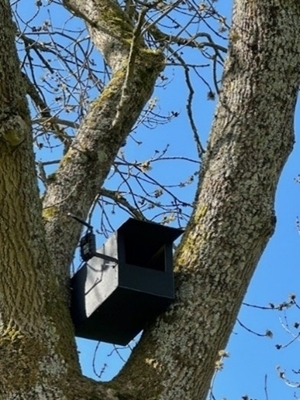By Sophie Jackson, Wildlife Recovery Placement Student
 There are few sights more recognisable than a kestrel hanging in the air, wings trembling as it locks onto prey below. For me, that hovering silhouette has always been a symbol of the countryside — familiar yet still thrilling to spot. But behind the elegance lies a more fragile story: kestrel numbers have been falling in many parts of the UK, and they are now Amber-listed as a species of conservation concern. Unlike some of our more celebrated raptors, kestrels often slip under the radar, which makes understanding their needs, and finding practical ways to support them, all the more important.
There are few sights more recognisable than a kestrel hanging in the air, wings trembling as it locks onto prey below. For me, that hovering silhouette has always been a symbol of the countryside — familiar yet still thrilling to spot. But behind the elegance lies a more fragile story: kestrel numbers have been falling in many parts of the UK, and they are now Amber-listed as a species of conservation concern. Unlike some of our more celebrated raptors, kestrels often slip under the radar, which makes understanding their needs, and finding practical ways to support them, all the more important.
Unlike most other UK raptors, kestrels don’t build their own nests. Instead, they make use of hollow trees, abandoned crow nests or ledges on barns and buildings. With fewer natural nesting sites available due to barn conversions and the loss of old trees for example, nest boxes are becoming an increasingly important way to support these well-loved creatures.
Testing nest box performance
Nest boxes have been proven to help kestrels, but we know surprisingly little about which locations they prefer. That is where my placement year project came in.


A motion-activated camera set up on a tree nest box
Working with the Selborne Landscape Partnership farmer cluster and the South Downs National Park (through their ReNature grant), we set out to discover whether kestrels prefer nest boxes mounted in barns or on trees. Led by Dr Francis Buner (GWCT) and Dr Matt Stevens (Hawk Conservancy), I installed 20 motion-activated Perdix Pro cameras in nest boxes): 10 in barns and 10 on trees to record kestrel activity throughout the breeding season. This non-invasive approach gave us an incredible window into kestrel life, from egg-laying to fledging, while helping us to answer that important question we set out to address.
What the results showed
Although our preliminary results did not show that kestrels were statistically significantly more likely to use nest boxes in barns, the story told by graphs and observations suggest a preference for barns does exist.
 A clutch of kestrel eggs found during a visitation. (Please note: only trained professionals can visit nestboxes).
A clutch of kestrel eggs found during a visitation. (Please note: only trained professionals can visit nestboxes).
Why might that be? Barns could offer a few advantages: better protection from wind and rain, fewer competitors from other bird species, and potentially more consistent hunting opportunities nearby.
Breeding success, measured by the number of chicks fledged, was slightly higher in barns too, though not by a large margin. In other words, while barns appeared to be the favoured option, tree boxes still proved valuable, giving kestrels additional places to nest across the landscape.
A window into kestrel life
Beyond nest choice, the camera footage also gave us fascinating insights into kestrel diets. Barn-nesting kestrels appeared to bring back a steadier supply of small mammals such as voles and mice, while tree-nesting pairs delivered a wider variety of prey - including lizards, slow worms, and insects.
 Kestrel caught on camera returning with a small mammal
Kestrel caught on camera returning with a small mammal
This flexibility shows just how adaptable kestrels can be, but it also hints at why barns may be preferred: the consistent supply of small mammals may offer a safer bet for raising chicks successfully.
 Kestrel caught on camera returning with a lizard
Kestrel caught on camera returning with a lizard
These preliminary results give us an encouraging first look into how kestrels use nest boxes, but there is still much more to learn. This study will continue and expand over the coming years, creating a larger dataset and therefore more reliable results. Further investigation also allows us to explore other questions, for example: Do egg-laying dates affect brood success? Do feeding frequencies affect clutch size? Do kestrels that nest in barns fledge more young than those that nest in trees?
Why does it matter?
Kestrels are more than just a beautiful sight in the sky. By keeping rodent numbers in check, they provide a natural form of pest control that benefit farmers and ecosystems alike. They are also important indicators of ecosystem health, sitting near the top of the food chain. Ensuring they have safe and suitable nesting sites is one way we can help them continue to thrive in our countryside. By understanding where kestrels prefer to nest, and how this influences their breeding, we can design and place boxes more effectively to support local populations.
Seeing how kestrels responded to different nest sites showed me how conservation isn’t always about sweeping changes, but often about small, practical steps that add up: the right nest box, the right location, the right support. For me, kestrels now represent both the challenges and the possibilities of conservation, and I feel proud to have played even a small part in helping secure their future.
© All photos Francis Buner